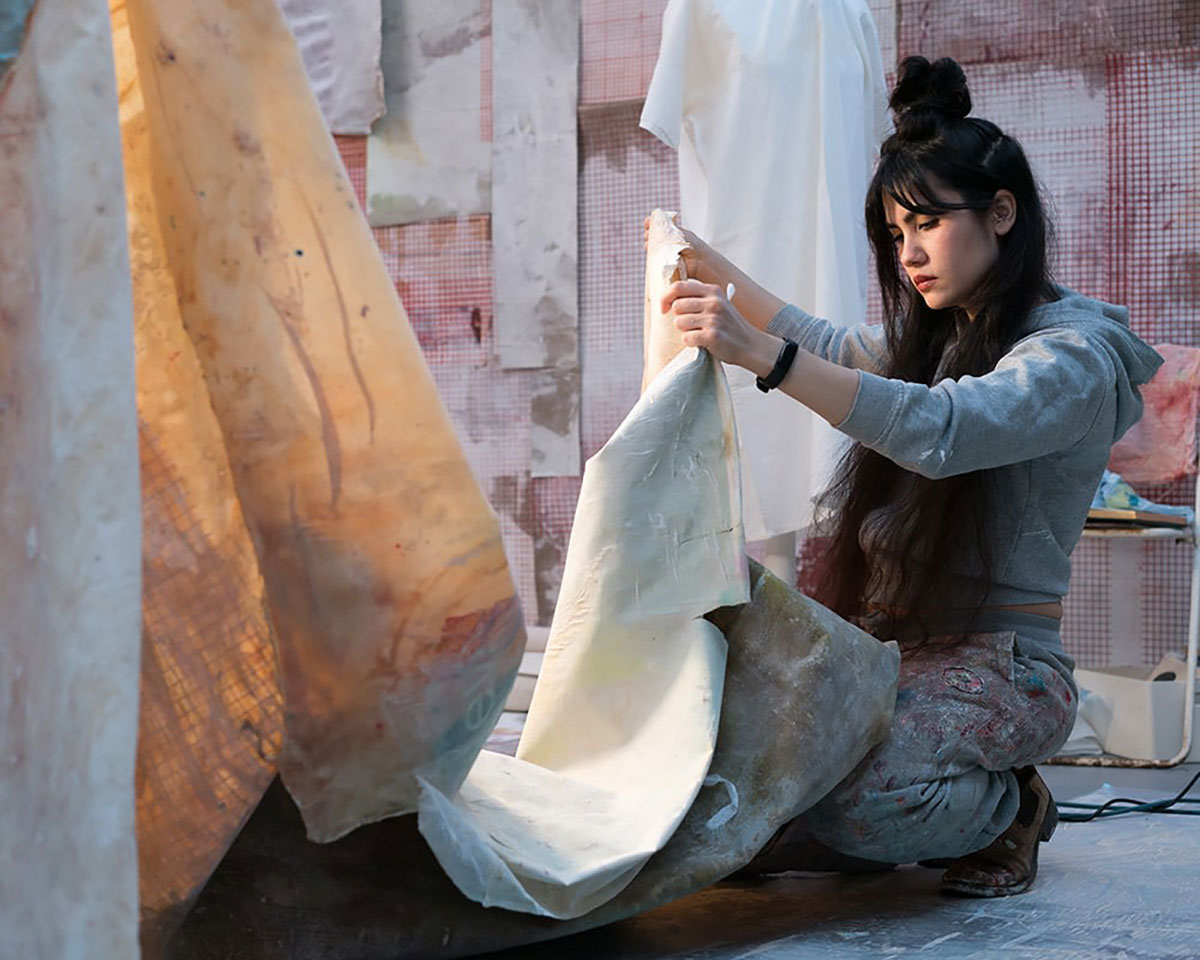ART CITIES: N.York-Mandy El-Sayegh
 Mandy El-Sayegh’s highly process-driven practice is rooted in an exploration of material, aesthetics, and language. Executed in a wide variety of media ranging from densely layered paintings to sculpture, installation, works on paper, and video, El-Sayegh’s work investigates the formation and dissolution of systems of order, be they bodily, linguistic, or political.
Mandy El-Sayegh’s highly process-driven practice is rooted in an exploration of material, aesthetics, and language. Executed in a wide variety of media ranging from densely layered paintings to sculpture, installation, works on paper, and video, El-Sayegh’s work investigates the formation and dissolution of systems of order, be they bodily, linguistic, or political.
By Dimitris Lempesis
Photo: Lehmann Maupin Gallery Archive
Featuring painting, sound, video, installation, and live elements, Mandy El-Sayegh’s solo exhibition “The Amateur” explores the curious experience of being an artist in the studio. Through a variety of media, El-Sayegh invites visitors into this interior world, seeking to activate material through chance encounters and opening up the gallery space to collaboration. A program of events will take place throughout the run of exhibition, including an immersive installation, a talk by the artist and open access opportunities for dancers to use the gallery as a rehearsal space. The exhibition’s title points to the artist’s interest in how a coded language and framing of professionalism supposedly infers legitimacy on creative acts of various kinds. With an emphasis on participation, El-Sayegh embraces amateurism, a moniker whose etymology, the Latin “amare” suggests one who engages in something out of love. The exhibition features new large-scale paintings, many of which are from a recent series by El-Sayegh that utilizes an abundance of blood-red pigment combined with found elements such as newspaper pages and her father’s Arabic calligraphy. These “fragments,” often seen within the artist’s densely layered compositions, are particularly stark and apparent. Also seen in the paintings on view are figurative passages reproduced from anatomical reference books. These motifs, which appear frequently in El-Sayegh’s work, are, for the artist, a symbolic re-introduction of the body into the abstract. Trapped within the paintings’ schema, sometimes by the form of a grid (which evokes a net or a crosshair) these splintered bodies also refer to the idea of suppressed subjects, denied individuality, wholeness, and representation. The idea of this suppression is also hinted at by the inclusion in some works of a reproduced watermark from a childhood passport belonging to the artist’s brother, as a displaced Palestinian. The intention of the watermark is to prevent reproducibility, but El-Sayegh renders the mark repeatedly through silk-screening. The imperfect repetition created by this process alludes to the gradual writing out of a people from history. Also included are reproductions of currency – silk-screened dollars and counterfeit banknotes. Selected for their aesthetic appeal, as well as the inherent mechanisms of irreproducibility in authentic notes, these symbols candidly suggest the connection between art objects and commerce.
In the second gallery, a vast installation covering two large walls includes layers of finished paintings over works-in-progress: swathes of linen that are painted, screen-printed, and collaged, overlapping in a complex patchwork. These pieces feature characteristics for which the artist’s work is well known: fragments of found imagery, frequent use of red tones, and the appearance of grids silk-screened across surfaces. The installation recreates the artist’s studio, in which works are hung in layers on the walls – El-Sayegh works on multiple pieces at once, often living with works for extended periods and gradually adding what they need to be complete. A new sound work, created by the artist with her frequent collaborator, composer Lily Oakes, permeates the galleries. The piece features samples including voice-notes sent by El-Sayegh to friends, and outtakes from an interview recorded in 2020 in which she haltingly introduces herself and her work. For El-Sayegh, this reflects her own ambivalent relationship with framing herself as an artist to the outside world. For the show’s opening, in a new performance work, “Akathisia”, El-Sayegh activated the installation by going through the same motions she performs in her own studio, moving intuitively in front of paintings-in-progress. This activation is a gesture that challenges the mythology around the figure of the artist, revealing the ultimate simplicity of standing in front of a painting while at the same time alluding to the intimacy and possibility of the studio. The movements are accompanied by projections featuring quick cuts between shots of studio processes along with snippets of current news and forensic pathology sources. For El-Sayegh, movement has become a means by which the living body is brought back into her art, and she has worked with collaborative performance for several years, usually within her exhibitions, by interacting with installations, works on gallery floors, and projections. For this exhibition, the artist invites others to inhabit the space, and has issued an open call for dancers to use the gallery to rehearse or improvise throughout the run of the show. These interventions connect with the methodologies El-Sayegh employs throughout her practice – the “cut-up” method, pulling together material from different sources, as well as experimentations that invite chance occurrences.
Photo: Mandy El-Sayegh in her London studio, 2023, Photo by Abtin Eshraghi
Info: Lehman Maupin Gallery, 501 West 24th Street, New York, NY, USA, Duration: 31/3-29/4/2023, Days & Hours: Tue-Sat 10:00-18:00, www.lehmannmaupin.com/
